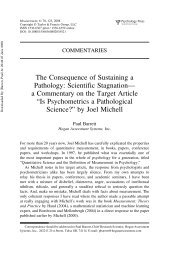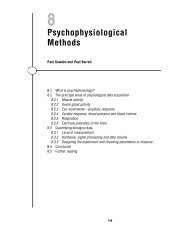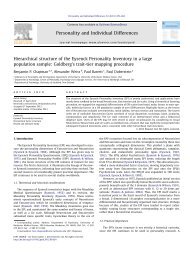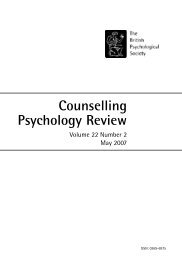Dimensions of variation on the CORE-OM - Paul Barrett
Dimensions of variation on the CORE-OM - Paul Barrett
Dimensions of variation on the CORE-OM - Paul Barrett
You also want an ePaper? Increase the reach of your titles
YUMPU automatically turns print PDFs into web optimized ePapers that Google loves.
Copyright © The British Psychological SocietyReproducti<strong>on</strong> in any form (including <strong>the</strong> internet) is prohibited without prior permissi<strong>on</strong> from <strong>the</strong> Society<str<strong>on</strong>g>Dimensi<strong>on</strong>s</str<strong>on</strong>g> <str<strong>on</strong>g>of</str<strong>on</strong>g> <str<strong>on</strong>g>variati<strong>on</strong></str<strong>on</strong>g> <strong>on</strong> <strong>the</strong> <strong>CORE</strong>-<strong>OM</strong> 201measurement <str<strong>on</strong>g>of</str<strong>on</strong>g> reducti<strong>on</strong> in symptoms and improvement in functi<strong>on</strong>ing had been <str<strong>on</strong>g>of</str<strong>on</strong>g>importance to <strong>the</strong>rapists and managers when <strong>CORE</strong>-<strong>OM</strong> was developed.O<strong>the</strong>r authors have attempted to operati<strong>on</strong>alize <strong>the</strong>se variables. Mundt, Marks, Shear,and Greist (2002) have shown that <strong>the</strong> self-report Work and social adjustment scale,which is specifically designed to measure functi<strong>on</strong>al impairment in work, homemanagement, social leisure, private leisure, and relati<strong>on</strong>ships, discriminates patientssuffering from depressi<strong>on</strong> and obsessive-compulsive disorder according to symptomseverity. However, correlati<strong>on</strong>s with standard symptom measures were <str<strong>on</strong>g>of</str<strong>on</strong>g> <strong>the</strong> order <str<strong>on</strong>g>of</str<strong>on</strong>g>.75, which is <str<strong>on</strong>g>of</str<strong>on</strong>g> <strong>the</strong> same order as that between <strong>the</strong> <strong>CORE</strong>-<strong>OM</strong> n<strong>on</strong>-risk domains.The Health <str<strong>on</strong>g>of</str<strong>on</strong>g> <strong>the</strong> Nati<strong>on</strong> Outcomes Scale (HoNOS) is used widely in <strong>the</strong> UK as anoutcomes measure in mental health services (Wing, Beevor, & Curtis, 1998). Only three<str<strong>on</strong>g>of</str<strong>on</strong>g> <strong>the</strong> 12 HoNOS scales have been shown to discriminate for outcomes in psychological<strong>the</strong>rapy out-patient populati<strong>on</strong>s (Audin, Margis<strong>on</strong>, Mellor-Clark, & Barkham, 2001).These were depressed mood, mental and behavioural problems, and problems withrelati<strong>on</strong>ships. There was a floor effect for scores <strong>on</strong> <strong>the</strong> o<strong>the</strong>r HoNOS scales, some <str<strong>on</strong>g>of</str<strong>on</strong>g>which are related to functi<strong>on</strong>ing, including activities <str<strong>on</strong>g>of</str<strong>on</strong>g> daily living, living c<strong>on</strong>diti<strong>on</strong>s,occupati<strong>on</strong> and activities, and behavioural problems. It seems that <strong>the</strong> level <str<strong>on</strong>g>of</str<strong>on</strong>g>dysfuncti<strong>on</strong> in <strong>the</strong> psycho<strong>the</strong>rapy and counselling populati<strong>on</strong> is too low to be detectedby many <str<strong>on</strong>g>of</str<strong>on</strong>g> <strong>the</strong> HoNOS scales, which have been shown to have greater utility forpsychiatric populati<strong>on</strong>s with severe and enduring mental illness (Orrell, Yard,Handysides, & Schapira, 1999).However, in a review, Mintz, Mintz, Arruda, and Hwang, (1992) dem<strong>on</strong>strateddifferential rates <str<strong>on</strong>g>of</str<strong>on</strong>g> recovery for occupati<strong>on</strong>al functi<strong>on</strong>ing and psychological distressin depressed patients. Reducti<strong>on</strong> in self-reported psychological distress <strong>on</strong> <strong>the</strong> BDI (Becket al., 1988) occurred within a few weeks <str<strong>on</strong>g>of</str<strong>on</strong>g> treatment with antidepressants, whereasimprovement in work-related functi<strong>on</strong>ing took l<strong>on</strong>ger. The unique feature <str<strong>on</strong>g>of</str<strong>on</strong>g> this researchwas that measures <str<strong>on</strong>g>of</str<strong>on</strong>g> functi<strong>on</strong>ing, although self-reported, were behavioural, includingsickness absence, involvement in c<strong>on</strong>flicts at work and work performance.These studies, taken toge<strong>the</strong>r with <strong>the</strong> results <str<strong>on</strong>g>of</str<strong>on</strong>g> <strong>the</strong> analyses <str<strong>on</strong>g>of</str<strong>on</strong>g> <strong>the</strong> <strong>CORE</strong>-<strong>OM</strong>, suggestthree reas<strong>on</strong>s for <strong>the</strong> difficulties in operati<strong>on</strong>alizing a distincti<strong>on</strong> between problems(symptoms) and functi<strong>on</strong>ing in psycho<strong>the</strong>rapy and counselling out-patient populati<strong>on</strong>s.Firstly, a significant part <str<strong>on</strong>g>of</str<strong>on</strong>g> <strong>the</strong> clinical evidence for psychological distress is to dowith aspects <str<strong>on</strong>g>of</str<strong>on</strong>g> functi<strong>on</strong>ing, such as lack <str<strong>on</strong>g>of</str<strong>on</strong>g> energy and social avoidance, hence <strong>the</strong>sevariables might be expected to be at least moderately correlated.Sec<strong>on</strong>dly, <strong>the</strong> degree <str<strong>on</strong>g>of</str<strong>on</strong>g> functi<strong>on</strong>al impairment in psycho<strong>the</strong>rapy and counsellingpopulati<strong>on</strong>s is relatively low compared with that in populati<strong>on</strong>s <str<strong>on</strong>g>of</str<strong>on</strong>g> patients with severeand enduring mental illnesses for whom functi<strong>on</strong>ing has been reliably measured usingo<strong>the</strong>r methods, and <strong>the</strong>refore might need sensitive measures in order to be detectable.Thirdly, questi<strong>on</strong>naires such as HoNOs that do successfully operati<strong>on</strong>alize adistincti<strong>on</strong> between functi<strong>on</strong>ing and psychological symptoms include indicators thatare not self-reported and/or go bey<strong>on</strong>d <strong>the</strong> realm <str<strong>on</strong>g>of</str<strong>on</strong>g> symptoms to include objectivefuncti<strong>on</strong>al problems. Whilst <strong>the</strong>re is a floor effect for HoNOS scales in psycho<strong>the</strong>rapyout-patient populati<strong>on</strong>s, because <strong>the</strong>se scales are designed to detect relatively severedysfuncti<strong>on</strong>, <strong>the</strong> review by Mintz et al. (1992) suggests that a way forward may be towrite items for functi<strong>on</strong>ing that carefully reflect actual behaviours and coping strategiesin daily life, without reference in <strong>the</strong> wording to <strong>the</strong> distress/well-being that mightaccompany <strong>the</strong>m, <strong>the</strong>reby minimizing covariance between measures <str<strong>on</strong>g>of</str<strong>on</strong>g> functi<strong>on</strong>ing andpsychological symptoms. The item loadings in Table 4 (discussed above) c<strong>on</strong>firm that












